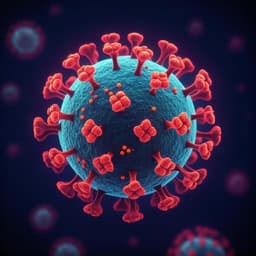
Medicine and Health
SARS-CoV-2 transmission and impacts of unvaccinated-only screening in populations of mixed vaccination status
K. M. Bubar, C. E. Middleton, et al.
This research conducted by Kate M. Bubar and colleagues delves into the impact of unvaccinated-only screening programs on controlling SARS-CoV-2 transmission across diverse vaccination scenarios. Findings reveal a nuanced relationship between vaccination rates and the dynamics of community spread, especially regarding vaccine breakthrough cases. Discover how population immunity shapes the effectiveness of targeted screening strategies.
~3 min • Beginner • English
Introduction
The COVID-19 pandemic has been partially mitigated by widespread vaccination, which is highly effective at preventing severe disease and reduces susceptibility to infection and onward transmission. However, breakthrough infections and transmission have been widely documented, especially with the emergence of the omicron variant. Prior to vaccines, repeated screening via RT-PCR and rapid antigen testing effectively reduced transmission. In 2021–2022, some policies shifted to require routine testing only for unvaccinated individuals, assuming they primarily drive spread. This study investigates transmission dynamics in mixed-vaccination populations to address three questions: (1) how vaccinated and unvaccinated groups contribute to community spread and hospitalizations across vaccination and prior infection rates; (2) how unvaccinated-only screening affects infections and hospitalizations; and (3) how strategies optimized in the delta era fare against variants with higher breakthrough and reinfection rates. The aim is to derive general principles rather than calibrated forecasts by exploring a wide parameter space for vaccine effectiveness, prior infection, and testing strategies.
Literature Review
Evidence before this study indicates: (1) routine testing programs (PCR and antigen) can break transmission chains in the absence of vaccination; (2) policy proposals in Italy and in U.S. healthcare settings implemented or considered unvaccinated-only screening; (3) vaccine effectiveness against infection and transmission is variant- and time-dependent, with notable reductions for omicron; (4) prior infection and hybrid immunity reduce risks of infection, transmission, and hospitalization, though estimates vary by vaccine product, time since vaccination or infection, and variant. Prior modeling and empirical work on universal screening and non-pharmaceutical interventions (NPIs) showed effectiveness depends on frequency, turnaround time, sensitivity, and participation, and that NPIs modestly reduce Reff. These strands motivate evaluating targeted, unvaccinated-only screening in the current mixed-immunity context.
Methodology
The authors developed a continuous-time SEIR compartmental model stratified by vaccination status (vaccinated V, unvaccinated U) and by prior infection status to capture hybrid immunity. The model tracks four transmission modes: U→U, U→V, V→U, and V→V. A small constant importation rate exposes all susceptibles. Vaccine effects and infection-acquired immunity are modeled as leaky reductions in susceptibility to infection, infectiousness if infected, and risk of hospitalization. Baseline assumptions for delta included: vaccines reduce susceptibility by 65% (VEi) and infectiousness by 86% (VEt); prior infection reduces susceptibility by 63% and infectiousness by 13%; hybrid immunity confers superior protection; hospitalization risk is additionally reduced among vaccinated and previously infected individuals. Simulations considered a range of context-specific baseline transmissibility (R0 under NPIs) from 2 to 6. A representative baseline scenario used R0 under NPIs = 4–5, population size N = 20,000, vaccination coverage varied widely, and prior infection rates typically around 35% (also varied 0–100%). The effective reproductive number Reff was computed analytically at t = 0 to predict outbreak size and to delineate screening impact regions. Unvaccinated-only screening was modeled by increasing the removal rate (isolation) of infected unvaccinated individuals upon positive tests, assuming RT-PCR-like sensitivity with 1-day turnaround. Screening paradigms included weekly testing at 50% compliance, weekly at 99% compliance, and (for omicron) twice-weekly at 99% compliance. Universal screening (testing both V and U) was also evaluated for comparison. Vaccine effectiveness scenarios included waning/low, baseline, boosted/high for delta, and plausible omicron-specific parameters with lower protection against infection and transmission. The authors defined three regions via Reff calculations: Region I (screening insufficient for control but reduces peak infections), Region II (screening brings Reff below 1 and controls transmission), and Region III (outbreak already mitigated without screening; screening adds little).
Key Findings
- Increasing vaccination coverage reduces total infections and hospitalizations, with herd immunity thresholds (Reff = 1) reached at lower vaccination levels when prior infection is higher (e.g., with 35% vs 50% prior infection, required vaccination for Reff = 1 dropped from 87% to 80% under baseline delta parameters).
- As vaccination increases, the share of infections that are breakthroughs increases. Under baseline delta parameters, the 50/50 breakthrough infection transition occurred at about 68% vaccination (ranging 63–75% as prior infection varied from 0–100%). Breakthrough hospitalizations surpass unvaccinated hospitalizations at much higher vaccination rates (about 90–96% under baseline delta parameters).
- Drivers of transmission shift with vaccination rates: under baseline delta assumptions (R0 under NPIs = 4, 35% prior infection), unvaccinated individuals cease to drive the majority of transmission once vaccination exceeds about 80% (varying roughly 76–82% as prior infection varies). For omicron, vaccinated individuals drive most spread above about 55% coverage; these thresholds decrease when vaccine effectiveness against infection/transmission wanes.
- Unvaccinated-only screening produces three impact regimes: Region I (reduces peak/total infections but Reff remains >1), Region II (reduces Reff below 1 and controls spread), Region III (minimal added benefit because Reff < 1 without screening). These regions are well predicted by analytic Reff with and without screening.
- Higher screening compliance substantially increases impact: moving from 50% to 99% compliance expands benefits (larger infection reductions) and shifts the boundary where screening controls transmission. Frequency, sensitivity, and turnaround time also matter; however, screening has little effect in Region III.
- Universal screening expands the effective control region compared with unvaccinated-only screening under otherwise identical conditions.
- Under plausible omicron parameters, unvaccinated-only screening generally cannot achieve Reff < 1 except at low vaccination levels combined with high-frequency testing and near-perfect compliance. Even twice-weekly unvaccinated-only testing cannot control omicron once vaccination rates are around 40% or higher, though it can still reduce and delay peaks (flatten the curve).
- Screening reduces U→U and U→V transmission, thereby increasing the relative contribution of breakthrough transmission. Screening shifts the vaccination-rate threshold at which vaccinated individuals cause the majority of transmission downward by up to ~15 percentage points (largest shift with 99% compliance and waning VE vs delta). However, screening does not materially change the vaccination-rate thresholds for majority-breakthrough infections or hospitalizations, which depend mainly on vaccination coverage and vaccine effectiveness.
- Reported transition ranges across scenarios: majority-breakthrough infections at 55–67% (waning delta), 63–75% (baseline delta), 83–84% (boosted delta), and 50–55% (omicron); majority-breakthrough hospitalizations at 83–88% (waning delta), 91–96% (baseline delta), and 83–93% (omicron).
Discussion
Findings indicate that in mixed-vaccination communities, unvaccinated-only screening can reduce infections and hospitalizations, but effectiveness depends critically on high participation and on epidemiological context. When population immunity (from vaccination and prior infection) is sufficiently high, outbreaks may already be controlled and screening adds little. When breakthrough and reinfection rates are high (e.g., omicron), unvaccinated-only screening may flatten the curve but is unlikely to control spread unless testing is very frequent and compliance is near perfect in low-vaccination settings. As vaccination rates rise, the unvaccinated contribute a smaller fraction of transmission, diminishing the value of targeting only the unvaccinated. Analytic Reff-based boundaries reliably predict where screening is impactful, offering a practical tool for policy. Comparisons suggest universal screening would outperform unvaccinated-only screening in enlarging the control region. NPIs can complement screening by modestly reducing Reff; however, given the diminishing returns of unvaccinated-only testing at higher vaccination rates, vaccination-centric strategies and high-impact NPIs may be more effective overall. Policymakers should anticipate a higher fraction of breakthrough infections and some breakthrough transmission in highly vaccinated populations due to imperfect vaccine effectiveness and should prioritize protecting those at highest risk of severe disease.
Conclusion
This work introduces a stratified SEIR framework to quantify contributions of vaccinated and unvaccinated groups to SARS-CoV-2 spread and to assess unvaccinated-only screening. It identifies three screening impact regimes via Reff calculations and shows that as vaccination increases, (i) most infections and hospitalizations decline in absolute number, (ii) the fraction that are breakthroughs rises, and (iii) vaccinated individuals eventually drive most transmission. Unvaccinated-only screening is most beneficial in under-vaccinated populations near but above the threshold where screening can tip Reff below 1; it has limited impact when vaccination is high or far from that threshold, and is generally insufficient to control omicron except under low-vaccination, high-frequency, high-compliance conditions. Future research should empirically evaluate vaccine-or-test programs, refine variant-specific immunity parameters, incorporate correlated behaviors and contact homophily, heterogeneous mixing, and imperfect isolation/adherence, and compare targeted vs universal screening alongside other NPIs.
Limitations
- Parameter uncertainty: The model uses fixed estimates of vaccine effectiveness against infection, transmission, and hospitalization, and of protection from prior and hybrid immunity; these vary by vaccine product, time since vaccination or infection, and variant, and omicron-specific estimates were limited.
- Perfect isolation assumption: The model assumes immediate and complete isolation upon positive tests; delays or non-adherence would proportionally reduce screening impact.
- Well-mixed population: Assumes no correlation between vaccination and prior infection status and no homophily by vaccination status in contact patterns; real-world mixing structure could shift quantitative results.
- Contextual transmissibility: R0 under NPIs was assumed within plausible ranges for delta and omicron; other settings or future variants may differ substantially.
- Scope: Simulations aim to derive general principles rather than calibrated forecasts; baseline population sizes and some reported values differ across sections, and results are not validated for specific jurisdictions. Testing assumptions (PCR-like sensitivity, 1-day turnaround) may not generalize to all implementations.
Related Publications
Explore these studies to deepen your understanding of the subject.







